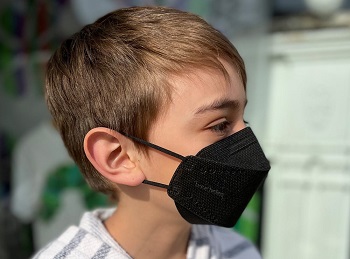The Invisible Armor Against COVID-19 in Schools: Swiss Study Reveals the Impact of Masks and Air Cleaners
COVID-19 News - Masks - Air Cleaners - Schools May 19, 2023 1 year, 11 months, 1 day, 10 hours, 43 minutes ago
COVID-19 News: Could the humble face mask and an unassuming air cleaner really hold the key to curbing COVID-19 transmission in schools? The answer, according to a recent Swiss study, is a resounding "yes".
 Please! When procurring masks for kids, make sure its a N95 mask
Please! When procurring masks for kids, make sure its a N95 mask
and not some plain cloth mask or surgical mask!
In a captivating study led by Nicolas Banholzer and Kathrin Zürcher of the University of Bern, a series of stringent tests were undertaken in two Swiss secondary schools to understand the dynamics of COVID-19 transmission among students. The study findings shed light on the effectiveness of simple measures such as masks and air cleaners in restricting the spread of the virus, especially during the tumultuous Omicron wave from January to March 2022.
The investigation revolved around 90 students from the two schools, examining the difference in viral transmission in classrooms where mask-wearing and air cleaner usage were either enforced or absent.
Interestingly, the study found airborne SARS-CoV-2 virus concentrations to be around 70% lower in classrooms with mask mandates and 40% lower where air cleaners were used. It also suggested that between two and 19 infections could be avoided during the study period with mask wearing.
While scientists have continuously faced challenges in tracking airborne pathogens, this study offers a breakthrough. The research team used a unique blend of molecular, environmental, and epidemiological data to demonstrate the persistence of the virus in the school environment, and the positive impact of mask mandates and air cleaners in reducing aerosol concentrations.
The crucial role of children and students in viral transmission has been a topic of hot debate since the onset of the pandemic and covered in various
COVID-19 News coverages. However, this study could help tilt the scales, shedding light on the highly effective role of mask mandates in curbing transmission. Moreover, it has paved the way for future epidemics, showing how rigorous monitoring could be employed to understand transmission patterns and evaluate the efficacy of suggested infection control measures.
Although the study was primarily focused on SARS-CoV-2, it occasionally detected other respiratory viruses such as adenovirus and influenza, signifying the potential broader applicability of its findings. The research also confirmed the sustained transmission of SARS-CoV-2 in school environments through molecular detection of the virus in aerosols and student saliva samples.
While the presence of air cleaners in classrooms showed a significant decrease in aerosol and particle concentrations, the study underlined the predominant role of mask mandates in curbing transmission. Compared to air cleaners, masks offered a more flexible and comprehensive line of defense, protecting students in various indoor settings beyond classrooms.
Of course, the study had its limitations. The results were observational and didn’t guarantee that the detected SARS-CoV-2 in the air or
aerosols would necessarily result in transmission. However, the consistent decrease in aerosol concentrations due to mask wearing and air cleaners points to a promising link between these preventative measures and a decrease in transmission.
This study serves as a stark reminder of the importance of accessible, affordable, and straightforward public health measures in managing the spread of respiratory infections. It outlines the potential effectiveness of a multi-pronged approach incorporating mask mandates, air cleaners, and potentially even professional building ventilation systems to combat the spread of infections in crowded indoor settings like schools.
Ultimately, this study provides a beacon of hope in our battle against airborne diseases. It demonstrates how simple, yet powerful interventions can limit the spread of viruses and protect the most vulnerable among us, our children. The future might hold many more pandemics, but with proactive and comprehensive approaches like this, we stand a better chance of winning the battle.
The study findings were published in the peer reviewed journal: PLOS Medicine.
https://journals.plos.org/plosmedicine/article?id=10.1371/journal.pmed.1004226
For the latest
COVID-19 News, keep on logging to Thailand Medical News.
